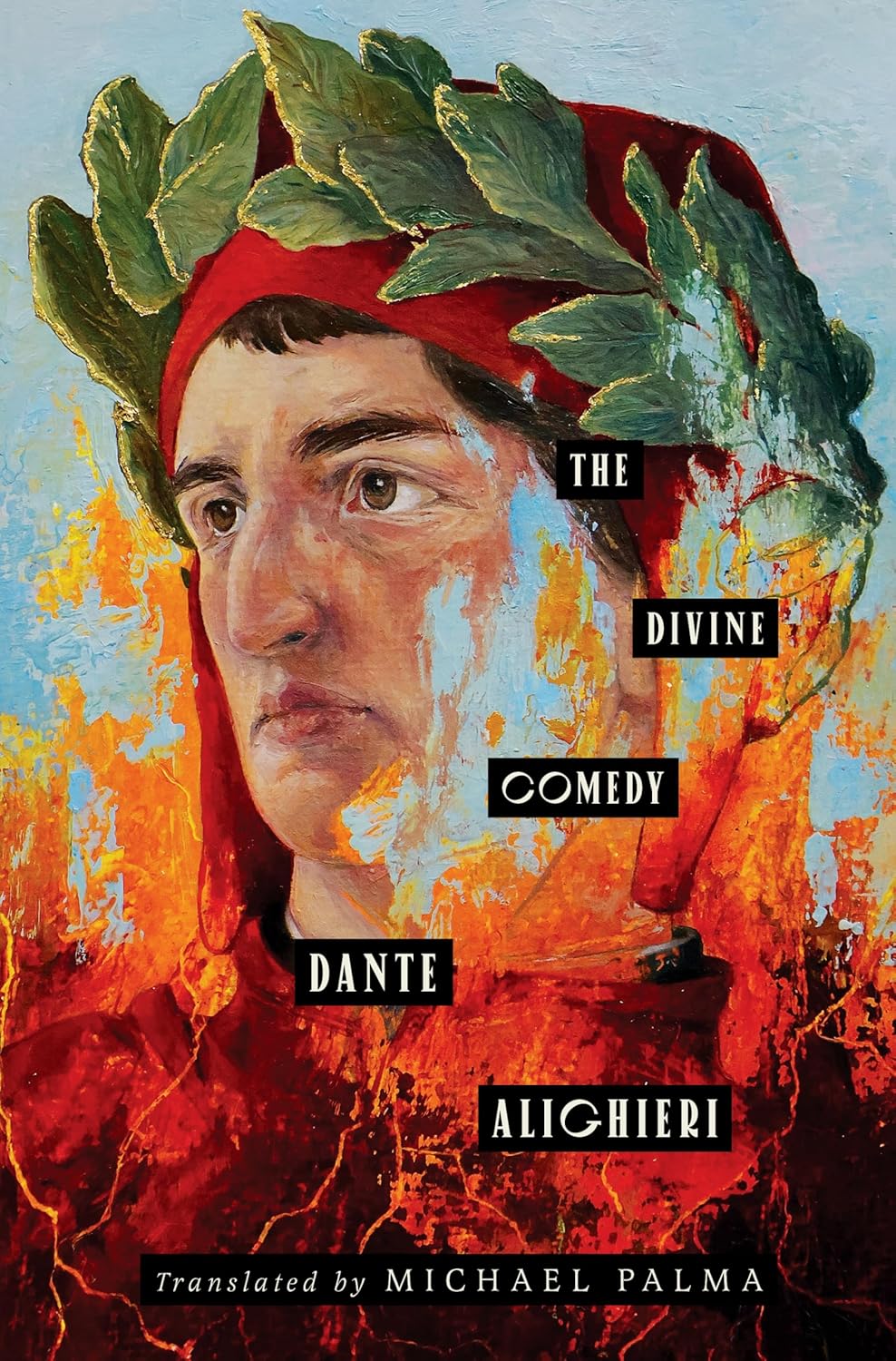|
Joseph S. Salemi _________________
___________________________________
Review of:
Great efforts of literary translation have a kind of majesty about them, often making them as famous as the original works that they address. Arthur Golding’s 1567 Englishing of Ovid’s Metamorphoses, the 1513 Scots translation of the Aeneid done by Gavin Douglas, and Pope’s 1743 version of the Iliad are prime examples of translations that have become iconic in their own right. This holds true even for certain works of criticism or scholarship, such as Samuel Johnson’s massive Dictionary of the English Language (1755), or Erich Auerbach’s brilliant Mimesis, or Jacob Burckhardt’s magisterial Civilization of the Renaissance in Italy. In my view, this will certainly become the case with Michael Palma’s newly published translation of Dante Alighieri’s Divina Commedia. Palma has completed all three books (Inferno, Purgatorio, and Paradiso), which now appear in a handsome one-volume edition put out this year by Liveright Publishing. It has an excellent introduction by Palma, and a note on his compositional methods, as well as 82 pages of detailed end notes that deal with every Canto. This should be the standard go-to text for an English translation of this major work for decades to come. In the case of Dante Alighieri’s great Commedia, we have a book of such signal importance for Western culture and religious belief that its power inevitably rubs off on the many translations of the text that have appeared over the centuries. In English alone, the number of versions is well over two hundred, ranging from that of Henry Wadsworth Longfellow to Charles Singleton to Dorothy Sayers to John Ciardi to Allen Mandelbaum, just to mention some of the more notable and valuable attempts that have become virtually canonical for English speakers without Italian. As with the Bible, some translations have become sacrosanct, like the 1611 King James Version, or the Douai-Rheims rendering. Each translation of the Divine Comedy has its own peculiar weaknesses and strengths. As the Italians say, every traduttore is a traditore in some respects. Whenever one translates from a foreign tongue there are inevitable compromises, managed obstacles, and reworkings that come into play in order to make the original text’s meaning accessible in clear idiomatic English. This problem is compounded if the translator wishes to maintain the meter and rhyme scheme of the text into something that approximates what Dante did. There are English transitions of Dante in free verse, blank verse, heroic couplets, prose, Spenserian stanzas, or modified terza rima. Michael Palma’s translation of the Inferno appeared more than twenty years ago, and it drew immediate attention because here was a rendering of Dante in perfectly interlinked terza rima, with the B rhyme of the first tercet carried over as the first and third rhyme of the following tercet. One could imagine pulling this off here and there, but doing it for an entire Canto? What kind of acrobatic tour de force was that? Surely it would lead to distortions and forced rhymes and mangled meaning. But that was not the case. Palma’s translation of Dante’s terza rima remained not just faithful to the Italian text, but also smooth and idiomatic English. Consider the first two tercets of the Inferno’s Canto IX: Quel color che viltà di fuor mi pinse, Attento sì fermò com’ uom c’ ascolta; Here is Palma’s rendering of the tercets: Noting the color cowardice gave me He stood like someone listening, for lack These are perfectly fine and graceful translations of the Italian text, and Palma maintains this kind of faithfulness consistently for the entire Canto, and—what is truly amazing—for the entire text of the Inferno! It must have been devilishly difficult, as any translator will attest. Translating Italian sonnets into English while maintaining both the rhyme scheme and the original meaning has for me been one of the most arduous tasks I have undertaken in poetry. After three or four, I simply said “Enough. I can’t do another one.” To do it for the thirty-four Cantos of the Inferno, as Palma has done, seems herculean in scope. But miracles do occur. Palma has now published the complete Divine Comedy (Inferno, Purgatorio, and Paradiso) in the same manner, in a book of nearly 600 pages, with extensive and detailed notes for every single Canto. All I can compare this magnum opus to is the engineering feat that planned, designed, organized, and brought off the moon landing in 1969. That accomplishment seemed utterly improbable, just as many believed that a full translation of the Divine Comedy into terza rima, in excellent and faithful English, with a full panoply of notes, was an impossible task. Palma has not been slavish in his devotion to terza rima. He is willing to use slant rhyme when necessary. Consider these tercets from Canto V of Purgatorio: ‘Questa gente che preme a noi è molta, ‘O anima, che vai per esser lieta Palma’s Englishing of this: “There are many there who press,” the poet said. “O soul who are going on to your reward Notice that
secured and reward are not perfect vowel
rhymes, but who would deny that this is an excellent version of the
Italian text? Palma has taken the Italian words disse and Però
pur in the first tercet, and used them to create the first and third
rhyme of his English rendering (said and instead), which
is exactly what they mean. He does the same when he renders esser
lieta as “to your reward” and gridando as “they implored.” He
manages this kind of careful matching and substitution throughout the
entire poem, and what is amazing is how infrequently he needs to use
slant rhyme or near rhyme. Most of the rhyme linkage is perfect. With a
poem of 14,000 lines this is a major tour de force, presenting us
with an English text of Dante that keeps the rhythmic pulse of the
original. Let’s look at another passage from the same Canto of Purgatorio, followed by Palma’s translation: Quivi sospiri, pianti e alti guai Diverse lingue, orribili favelle, * * * Sighs and laments and loud wails filled my ears, A babble of tongues, harsh outcries of despair, Here also Palma expertly navigates the Italian, adding the perfectly acceptable filled my ears to make a rhyme with tears, and putting beating of hands in the fifth line of the English, even though it is in the sixth line of the original text. A more rigid translator would not do this, and one who was producing an unrhymed English version would not feel compelled even to think about it. But having chosen to be loyal to Dante’s terza rima, Palma must pay intense attention not just to the surface meaning of the Italian, but also to its possible suggestions and implications, at least insofar as it can prompt him to find alternate English wording and syntax. There are still some who distrust this kind of translation, feeling that a straightforward rendering of text (even a word-for-word calque), is the only way to avoid being a traditore to the original author’s intentions. Some medieval translations were so slavish that they read like gibberish generated by a machine, and this was frequently so when a religious text was being translated—one that had a sacrosanct aura of divinity about it. But serious translators have always known better, and have given themselves the latitude and leeway to render a foreign work into the natural rhythms and syntax of one’s own language. St. Jerome knew this when he translated the Hebrew and Greek Bible into Latin, and William Caxton knew it when he translated French texts into early modern English. I’m not talking about “modernizing” a text—far from it. There are some translations of Homer by modern scholars who have made ancient Greek heroes and ladies speak as if they were brain-dead yuppie metrosexuals, or California valley girls. Such things are not translations, but abortions. What I means is that a world-class translator, like Richmond Lattimore, or Richard Wilbur, or Michael Palma, is going to produce an English text that is perfectly clear, elegant, well-expressed, idiomatic, and delightful to educated contemporary readers, in their accepted educated idiom. Regardless of the merits or demerits of any English translation, another factor to be considered is the appended notes and commentary. Scholarly academic translators of the Divine Comedy generally include informative notes and references that are necessary and helpful in understanding a text that is seven centuries old. I have always found the notes of Dorothy Sayers and John Ciardi to be immensely useful, even if I think certain passages rendered by other translators to be superior or more graceful. In short, there is great deal to be considered when judging a new translation of the Divine Comedy. Palma’s notes are commendable in two ways. First, they
are not overwhelming—there are usually no more than ten to twenty
individual notes per Canto, and each of them is no longer than it need
be, but when an important point has to be clarified or explained, the
note will be sufficiently discursive to do the job. Second, when his
notes mention another text they never refer to Dantean scholarship or
commentary, but only to crucial ancient sources like the Bible,
Patristic commentary, or ancient classical authors. The rare exceptions
are when Palma mentions an important point made by some scholar or by
another translator, and this is to give proper and due credit for an
idea to its source. The notes are designed to be helpful and
non-intrusive, which can be hard to manage with a text this old, and
with a contemporary world that has become historically illiterate. This is a translation for the ages. If it could be made into an inexpensive paperback, it might well become the common Dante translation for survey courses in the Humanities. For years I myself used John Ciardi’s excellent version when teaching Dante, and I still have no complaints about that rendering. But if I were still teaching Dante, Palma’s text would be the one I would recommend and assign. I might also add that even for Anglophone readers who are fluent in Italian, Palma’s text would be proof that a masterly translation can very well be as much of a masterpiece as the masterpiece it serves.
Joseph S. Salemi has published poems, translations, and scholarly articles in over one hundred journals throughout the United States, Canada, and Great Britain. His four collections of poetry are Formal Complaints and Nonsense Couplets, issued by Somers Rocks Press, Masquerade from Pivot Press, and The Lilacs on Good Friday from The New Formalist Press. He has translated poems from a wide range of Greek and Roman authors, including Catullus, Martial, Juvenal, Horace, Propertius, Ausonius, Theognis, and Philodemus. In addition, he has published extensive translations, with scholarly commentary and annotations, from Renaissance texts such as the Faunus poems of Pietro Bembo, The Facetiae of Poggio Bracciolini, and the Latin verse of Castiglione. He is a recipient of a Herbert Musurillo Scholarship, a Lane Cooper Fellowship, an N.E.H. Fellowship, and the 1993 Classical and Modern Literature Award. He is also a four-time finalist for the Howard Nemerov Prize. His upcoming books, Gallery of Ethopaths, and a collection of critical essays, are forthcoming. |
 A
TRANSLATION
FOR THE
AGES
A
TRANSLATION
FOR THE
AGES
